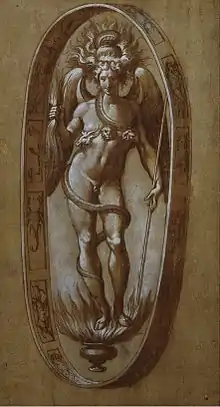Phanes
In Orphic cosmogony, Phanes /ˈfeɪˌniːz/ (Ancient Greek: Φάνης, romanized: Phánēs, genitive Φάνητος) or Protogonos /proʊˈtɒɡənəs/ (Ancient Greek: Πρωτογόνος, romanized: Prōtogónos, lit. 'first-born') is the primeval deity who is born from the cosmic egg at the beginning of creation. He is referred to under various names, including Erikepaios /ˌɛrɪkəˈpiːəs/ (Ancient Greek: Ἠρικαπαῖος/Ἠρικεπαῖος, romanized: Ērikapaîos/Ērikepaîos, lit. 'power') and Metis ("thought").[1]
| Phanes | |
|---|---|
 A 16th-century illustration of Phanes by Francesco de' Rossi | |
| Symbol | Serpent |
| Parents | None/Orphic Egg or Chronos and Ananke |
| Greek deities series |
|---|
| Primordial deities |
Mythology
In Orphic cosmogony, Phanes is often equated with Eros or Mithras, and has been depicted as a deity emerging from a cosmic egg, entwined with a serpent. He had a helmet and had broad, golden wings. The Orphic cosmogony is quite unlike the creation sagas offered by Homer and Hesiod. Scholars have suggested that Orphism is "un-Greek" even "Asiatic" in conception, because of its inherent dualism.[2]
Chronos (Time) is said to have created the silver egg of the universe, out of which burst the first-born deity Phanes, or Phanes-Dionysus.[3] Phanes was a male god, in an original Orphic hymn he is named as "Lord Priapos"[4] although others consider him androgynous.[1] Phanes was a deity of light and goodness, whose name meant "to bring light" or "to shine";[5][6] a first-born deity, he emerged from the abyss and gave birth to the universe.[6] Nyx (Night) is variously said to be Phanes' daughter[3] or older wife, she is the female counterpart of Phanes, and she is considered by Aristophanes as the first deity. According to Aristophanes,[7] in a play where Phanes is called ‘Eros’, Phanes was born from an egg created by the first deity Nyx and placed in the boundless lap of Erebus, after which he mates with Chaos and creates the flying creatures.[7][lower-alpha 1]
In Orphic literature, Phanes was believed to have been hatched from the World-Egg of Chronos (Time) and Ananke (Necessity or Fate) or Nyx in the form of a black bird and wind. His older wife Nyx called him Protogenus. As she created nighttime, Phanes created daytime, and also invented the method of creation by mingling. He was made the ruler of the deities. This new Orphic tradition states that Phanes passed the sceptre to Nyx; Nyx later gave the sceptre to her son Ouranos; Cronus seized the scepter from his father Ouranos; and finally the scepter held by Cronus was seized by Zeus, who holds it at present. Some Orphic myths suggest that Zeus intends to pass the scepter to Dionysus.
According to Damascius, Phanes was the first god "expressible and acceptable to human ears" ("πρώτης ητόν τι ἐχούσης καὶ σύμμετρον πρὸς ἀνθρώπων ἀκοάς").[8]
Another Orphic hymn states:[9]
- You scattered the dark mist that lay before your eyes and, flapping your wings, you whirled about, and throughout this world you brought pure light. For this I call you Phanes, I call you Lord Priapos, I call you sparkling[10] with bright eyes.
The Derveni Papyrus refers to Phanes:
- Of the First-born king, the reverend one; and upon him all the immortals grew, blessed gods and goddesses and rivers and lovely springs and everything else that had then been born; and he himself became the sole one".[11]
Dionysus or Zagreus of the Orphic tradition is intimately connected to Protogonos. In Orphic Hymn 30, he is given a list of epithets that also allude to Protogonos:
πρωτόγονον
primeval
διφυῆ
two-natured
τρίγονον
thrice-born
Βακχεῖον ἄνακτα
Bacchic lord
ἄγριον
savage
ἄρρητον
ineffable
κρύφιον
secretive
δικέρωτα
two-horned
δίμορφον
two-shaped
Footnotes
- The passage is quoted in the play as an attempt by "the birds" to demonstrate that flying creatures are well-known to be senior to all other living creatures – older, even, than many of the gods.[7]
References
- Santamaría Álvarez, Marco Antonio (2016). "Did Plato know of the Orphic god Protogonos?". In García Blanco, María José; Martín-Velasco, María José (eds.). Greek Philosophy and Mystery Cults. p. 207. ISBN 978-1-4438-8830-1 – via Google Books.
- Russell, Jeffrey Burton (1987). The Devil: Perceptions of Evil from Antiquity to Primitive Christianity. Cornell University Press. p. 137. ISBN 0-8014-9409-5.
- Leeming, David Adams (2010). Creation Myths of the World: An Encyclopedia. p. 119. ISBN 978-1-59884-174-9.
- Athanassakis-1977-Hymn6: For this I call you Phanes and Lord Priapos and bright-eyed Antauges.
- Coulter, Charles Russell; Turner, Patricia (2012). Encyclopedia of Ancient Deities. Jefferson: McFarland & Company. p. 381. ISBN 978-0-7864-9179-7. OCLC 1289371188.
- Campbell, Joseph (1978). The Mysteries. Princeton University Press. p. 71. ISBN 978-0-691-01823-2.
- Aristophanes. The Birds. 690–702.
- cf. B. 75–80, K. 54
- "Hymn 6 to Protogonos". The Orphic Hymns. Translated by Athanassakis, Apostolos N.; Wolkow, Benjamin M. (Kindle ed.). Baltimore, MD: Johns Hopkins University Press. 29 May 2013 [1977]. ISBN 978-1421408828.
- "ἀνταυγής". lsj.gr/wiki. Retrieved 2021-06-06.
- Kouremenos, Parássoglou, and Tsantsanoglou (2006)
- "Hymn 30". The Orphic Hymns. Translated by Athanassakis, Apostolos N.; Wolkow, Benjamin M. (Kindle ed.). Baltimore, MD: Johns Hopkins University Press. 29 May 2013 [1977]. ISBN 978-1421408828.
Sources
- Lang, Andrew (1887). . . Vol. 1. pp. 315–319 – via Wikisource.
- Iozzo, Mario (2012). "La kylix fiorentina di Chachrylion ed Eros Protogonos Phanes". Antike Kunst (55): 52–62.
- "Phanes". The Suda On Line: Byzantine Lexicography.
External links
 Media related to Phanes (deity) at Wikimedia Commons
Media related to Phanes (deity) at Wikimedia Commons